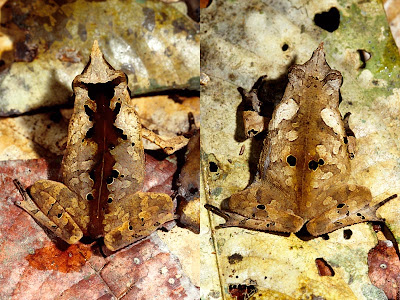The idea was to get farther into the forest than the hunters usually go, to see if we could photograph primates and large mammals. Jim was also very interested in the palm species we may find. We took our boat as far up the Quebrada Blanco as possible, and then along with 3 locals headed north, at a right-angle to the river, and set up camp.
The forest here was different from what we had been traveling through, with a higher number and diversity of palm species and an abundance of thorny, climbing ferns. We also frequently encountered "supay chacras" or "devil's gardens". These cleared areas in the forest were a mystery. It was assumed that there was a patch of clay that was so dense that undergrowth simply couldn't get a foothold. Our camp was near a large supay chacra, and both Jim and I noticed that the only plants that grew in them was a small, stout woody plant with fuzzy purplish stems.

These plants were fiercely guarded by ants. At the time, we wondered if the ants may have been responsible for the clearing, as we have seen with leafcutter ant nests. We now know this to be the case.
Anyway, one thing we discovered among the supay charcras and climbing ferns was a tremendous variety of frog and toad species. And that is the reason for this blog...or one of them is, actually:

When I first saw one of these toads, I was excited, it was unlike anything I had ever seen...but I was also certain that an animal so unique, with such incredible form and camouflage must be well known, and I will be able to put a name to it when I returned home and consulted the literature. That, coupled with the fact that they weren't at all difficult to find (I think we found about 20 specimens all together), led me to not pay so much attention to the "leaf-toads" when I had them in-hand.
I was wrong.
After looking through an obscene number of books and contacting herpetologists such as Bill Duellman, I still came up blank. At Duellman's suggestion, I contacted Marinus Hoogmoed who was working on the Bufo (now Rhinella) margaritifer group of toads. Hoogmoed was excited after I emailed him a couple of jpegs in 1995, and he said that he would like to use my images in a paper he was working up describing this complex. Soon after that, I lost touch with him and recent efforts at contacting him have failed.
Over the last couple of years I have searched for images of any tropical toad that looks even similar to what we found at Tamshiyacu-Tahuayo, and have found only one...and that one is quite different, but has a somewhat similar form. Here are some more of my pictures of this amazing animal:




 The largest of these (I presume adults) were about 3 to 4 inches from snout-to-vent. The skin felt smooth and velvety. They were all found in terre firme forest and most in the vicinity of a supay chacra. Whether these animals preferred the supay chacras, or we preferred the ease with which one can move in the ant-made clearings may never be known.
The largest of these (I presume adults) were about 3 to 4 inches from snout-to-vent. The skin felt smooth and velvety. They were all found in terre firme forest and most in the vicinity of a supay chacra. Whether these animals preferred the supay chacras, or we preferred the ease with which one can move in the ant-made clearings may never be known.I have made 6 trips back to this location at various times of the year, including December–when they were originally found–and have not been able to re-locate this species.
And there is the purpose of this blog: if anyone reading this is familiar in any way, or even might have a hunch about what species this is...or any other information, please share it here in the comments.
Thank you.
This post is part of the House of Herps carnival at The Little House in the Not-So-Big-Woods. I hope you visit and see the other entries. It's a pretty varied group.
ReplyDeleteRhinella margaritifera - easy
ReplyDeleteI spoke with a few people that do field work in Peru about this toad.
ReplyDeleteLily O. Rodríguez told me that this is a new species of Rhinella spp
She was a part of the expedition that discovered this toad in Yavari area in Peru in 2003.
This toad is a new species of Rhinella spp.
It was discovered in the area of Yavari in 2003.
It's new to science and currently being described by
M. Hoogmoed
From the field work in Nov 2003.
We recorded at least three species in the
Bufo typhonius complex, including what may be Bufo
margaritifer. A fourth species, resembling B. dapsilis,
is new to science and currently being described by
M. Hoogmoed (pers. comm.). This taxon (Bufo sp. nov.
“Pinocchio”), remarkable for its velvety skin and long
“nose”, was one of the most common amphibians at the
Quebrada Buenavista site (Figure 5B).
w.http://fm2.fieldmuseum.org/rbi/pdfs/peru11/per11_entire.pdf